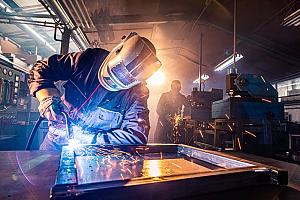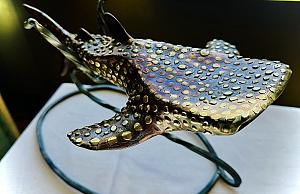- FMA
- The Fabricator
- FABTECH
- Canadian Metalworking
Categories
- Additive Manufacturing
- Aluminum Welding
- Arc Welding
- Assembly and Joining
- Automation and Robotics
- Bending and Forming
- Consumables
- Cutting and Weld Prep
- Electric Vehicles
- En Español
- Finishing
- Hydroforming
- Laser Cutting
- Laser Welding
- Machining
- Manufacturing Software
- Materials Handling
- Metals/Materials
- Oxyfuel Cutting
- Plasma Cutting
- Power Tools
- Punching and Other Holemaking
- Roll Forming
- Safety
- Sawing
- Shearing
- Shop Management
- Testing and Measuring
- Tube and Pipe Fabrication
- Tube and Pipe Production
- Waterjet Cutting
Industry Directory
Webcasts
Podcasts
FAB 40
Advertise
Subscribe
Account Login
Search
Fiber laser system overcomes obsolescence with EtherCAT, PC-based control platform
- May 23, 2024
- News Release
- Automation and Robotics
Situation
To remain relevant and successful, long-established companies must honor their past without losing sight of the future. This is the approach that metal fabricating machine builder Cincinnati Inc. (CI), Harrison, Ohio, has taken since its founding in the late 1890s.
The company considers technology shifts carefully. The wrong selection of control hardware, networking, or automation software could spill beyond new machinery to legacy products. However, not staying up to date also creates pitfalls.
“In the ’80s and ’90s, we led the market as one of the first U.S. laser cutting machine builders. But the pace at which we had to add features, remove features, or change how we did things typically took about three years. Today, it’s six to 18 months,” said Troy Wilson, CI’s product manager, table products. “The fiber laser world moved so quickly that platforms we’d used couldn't adapt to deal with new technology.”
Recently, CI engineers were tasked with building upon the company’s legacy while integrating future-proof automation for the industry’s new era. The challenge of supporting legacy equipment while building controls in-house buried the engineers in redesign work. They were constantly sourcing alternatives for obsolete chip sets or components.
In addition, customers regularly wanted to adapt machines for higher-wattage lasers or other features, so a future platform would need to be flexible to connect and disconnect devices and change parameters easily in software.
So when development of the CLX fiber laser system began in 2018, the company knew it needed to design more than a dynamic laser cutting machine. Most important for its customer base—about one-third OEMs, two-thirds job shops—the laser needed to be fast, intuitive, and dependable.
“If the lasers go down, you also have to send press brake operators home, and then in a number of hours, you have to send welders home,” Wilson said. “That laser is critical to the overall operation.”
Resolution
When designing the fiber laser system, the engineering team determined that EtherCAT and PC-based automation from Beckhoff checked the boxes for power, speed, and extensibility.
“We needed an off-the-shelf platform that could meet our requirements today and, more importantly, add features, benefits, and new abilities for the machines of tomorrow,” Wilson said.
The CLX fiber laser system features a C6030 ultracompact industrial PC from Beckhoff to control the entire CNC machine. The scalable machine controller offers ample processing power with flexible interface options, and it’s designed to be backwards compatible and to accommodate future technology developments.
“When we built our own CPUs, it was paralyzing when chips and other components expired,” said Matt Garbarino, business unit leader – new machinery sales. “To have a vendor deal with all that for us is a game-changer.”
TwinCAT 3 automation software, Beckhoff’s universal engineering and run-time platform, also helps ensure future-proof scalability. From IEC 61131-3 languages with their object-oriented extensions to custom and predefined function blocks to computer science standards, the software’s integration into Microsoft Visual Studio empowers engineers to program in the languages that best fit the application. This was a major step ahead from the previous vendor’s proprietary script.
“Being able to use object-oriented programming in TwinCAT made it so much easier to get going with our next generation of code,” says Andrew Franxman, electrical design engineer at CI. “We also use the PLC library, CNC package, and ADS communication, which is how we connect with our higher-level software.”
Despite more robust programming, the user interface on the CLX has become even more intuitive, eliminating the need to dig through Ladder Logic to troubleshoot or adjust the machine. A dual-screen CP3924 control panel offers a 24-in. interface.
“We’re very happy with the durability, form, and function of the Beckhoff control panel. With the dual screens and the mounting for the keyboard physically attached, it offers a modern user experience,” Wilson said.
In addition, the EtherCAT industrial Ethernet system and servo drive technologies from Beckhoff enhance performance and scalability.
“The hot connect capability—to plug and unplug EtherCAT equipment—has been very powerful, especially with our automatic nozzle changer,” explained Zackery Bischoff, CI’s electrical engineering manager. “That flexibility will be even more important as we integrate robots and possibly even a press brake in a comprehensive manufacturing line.”
“With our previous machines, the limitations were with control hardware and networking. That is no longer the limit,” Wilson said. “Now, our limit is physics.”
Related Companies
subscribe now

The Fabricator is North America's leading magazine for the metal forming and fabricating industry. The magazine delivers the news, technical articles, and case histories that enable fabricators to do their jobs more efficiently. The Fabricator has served the industry since 1970.
start your free subscription- Stay connected from anywhere

Easily access valuable industry resources now with full access to the digital edition of The Fabricator.

Easily access valuable industry resources now with full access to the digital edition of The Welder.

Easily access valuable industry resources now with full access to the digital edition of The Tube and Pipe Journal.
- Podcasting
- Podcast:
- The Fabricator Podcast
- Published:
- 06/11/2024
- Running Time:
- 61:23
Jeff Cupples, the president of Jackson, Tenn.-based Cupples J&J Company, discusses his experience with laser cutting machines and...
- Trending Articles
Miller Fabrication Solutions employees add more value with automation

Customer communication drives growth for contract fabricator

It’s time to get transparent about material properties

A metal fabrication company’s 5-step transformation process

Colorado-based Kennedy Coachworks takes on car restorations

- Industry Events
Golf 4 Manufacturing
- June 3 - August 18, 2024
- Waukegan,
Advanced Laser Application Workshop
- June 25 - 27, 2024
- Novi, MI
Precision Press Brake Certificate Course
- July 31 - August 1, 2024
- Elgin,
Laser Welding Certificate Course
- August 6 - 8, 2024
- Farmington Hills, IL
The Fabricator's Technology Summit
- August 20 - 21, 2024
- Eglin, IL


























